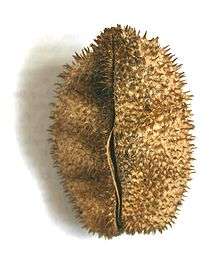Pithecoctenium
Pithecoctenium, monkey's-comb,[1] is a Bignoniaceae genus of some 20 species of climbing shrubs occurring in the Caribbean and Tropical South America from Brazil to Mexico. Leaves are opposite with 3 entire and stalked leaflets, the terminal leaflet sometimes being modified into a tendril. The genus has distinctive prickly capsules.[2] The white or violet flowers are in simple racemes, sometimes branched. The genus is closely related to Bignonia and Anemopaegma.
| Pithecoctenium | |
|---|---|
 | |
| fruit of Pithecoctenium sp. | |
| Scientific classification | |
| Kingdom: | |
| (unranked): | |
| (unranked): | |
| (unranked): | |
| Order: | |
| Family: | |
| Genus: | Pithecoctenium |
| Species | |
|
About 20, see text | |
Pithecoctenium crucigerum (L.) A.H. Gentry has become an invasive weed in Australia.[3] Chemical investigation of methanol extracted from this species yielded the iridoid glycoside theviridoside along with five phenylethanoid glycosides (verbascoside, isoverbascoside, forsythoside B, jionoside D and leucosceptoside B), these last all active against DPPH.[4]
Pithecoctenium translates to 'monkey comb'.
Species
- Pithecoctenium carolinae
- Pithecoctenium crucigerum
- Pithecoctenium cynanchoides
References
- "Pithecoctenium". Natural Resources Conservation Service PLANTS Database. USDA. Retrieved 6 October 2015.
- Dictionary of Gardening - Royal Horticultural Society (1956)
- http://www.backyardnature.net/mexnat/monkcomb.htm
- "Iridoid glycosides from the stems of Pithecoctenium crucigerum (Bignoniaceae)". Phytochemistry. 68 (9): 1307–11. May 2007. doi:10.1016/j.phytochem.2007.02.002. PMID 17382978.
External links
| Wikispecies has information related to Pithecoctenium |